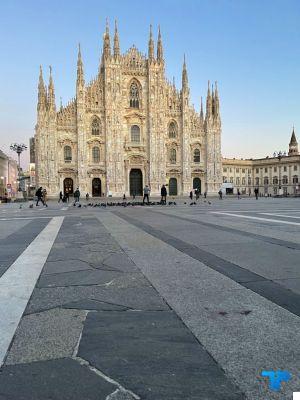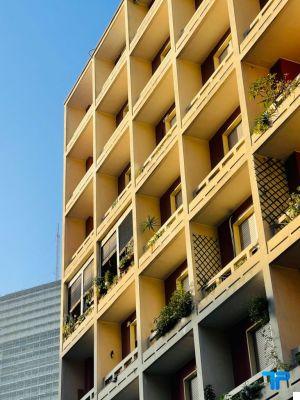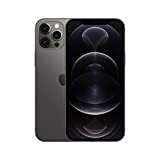IPhone 12 Pro Max Photo Review
iPhone 12 Pro Max as you all know by now it is the latest top of the range from Apple. It differs from its brothers in size and in particular in the photographic module. And it is precisely for the characteristics related to the triple camera that it deserves a dedicated photographic study.
I will not go too far telling you the technical specifications by thread and by sign because I have already done it - you can find everything here - but some quick information to recap everything is due. To begin with, iPhone 12 Pro Max has a new sensor, larger in size but with the same number of pixels as in the past: 12 million. And if therefore the pixels have remained unchanged in number, having a greater surface on which to act, they too have been enlarged. This transformation allows individual pixels to capture more light, ensuring cleaner, more detailed results with more natural colors.

Another great novelty from a structural point of view of the main camera we find it in a redesigned optics, which today is made up of more elements and a larger diaphragm. This is another way to refine the rendering of captured images, with greater engraving and less optical distortions. The optical design, in fact, plays a fundamental role in the way in which the light reaches the sensor and at the same time on the accuracy of the reproduction. Basically, the more quality the lenses inside our lens are, the more light will reach the sensor without creating annoying reflections. But the optical quality also affects the distortions, which in small lenses are always around the corner. It is no coincidence that professional lenses are large and heavy in photography. Inside there are, in fact, glass and large lenses that lead to quality results. To give you an idea, a professional lens that can be more or less equivalent in focal length and aperture to that of the iPhone, can cost around 1000 euros and weigh 400 grams. This is just to say how the work done in such a miniaturized sector is truly excellent.

Further delving into the features of the main camera we also discover a really efficient optical stabilization system. Apple for this sensor has opted to change the standard adopted on the other optics of this smartphone and all other iPhones equipped with stabilization. No longer on the optics but directly on the sensor. It was probably a choice also dictated by the size of the module which would have increased further. But it is certainly a solution that further improves the sector, even for videos. Shooting is very stable and even in photography it allows us to shoot without problems without problems with very long times, up to two seconds. It should be emphasized that the night mode also comes into play with these exposures, but the results are really excellent.
The stabilization on the sensor with its over 5000 micro-movements per second manages to counteract the accidental and perhaps imperceptible movements that we do when shooting. And this is certainly one of the features that most helps us in everyday shots and that we will appreciate a lot without perhaps knowing exactly the mechanism. But Fjona thought about it in the video to make it very clear. Check it out!
Between stabilization, sensor size, wider aperture and Lidar working in low light and obtaining excellent results is a reality. The Lidar helps us focus in the dark, the rest works to show us even what our eyes cannot see. But all this talk about the possibility of photographing late at night leads me to a purely photographic consideration. While it's incredible what iPhone 12 Pro Max can potentially do, it's not actually taking pictures, but a technical demonstration of its computing power. It amazes us, it enchants us, it makes us fall in love with these devices, but it is not photography. I would like this to be clear. Photography means writing with light, not creating it where it is not there.
However, it is precisely starting from this assumption that iPhone 12 Pro Max amazed me: There aren't many settings that we can adjust from Apple's Camera app, but also just being able to control exposure leads us to take pictures and take advantage of all this technology to the advantage of the image. Intervening on this parameter allows us to achieve excellent quality results, realistic photographs and at the same time also rich in details.

I promised you not to overdo the more technical part and then quickly move on to the other two modules that complete the trio. On the iPhone 12 Pro Max we have a lens super wide angle which is equivalent to a 13mm with fixed aperture f / 2,4 and a 65mm telephoto. These two modules are also characterized by a resolution of 12MP. The overall focal range offered is therefore equal to 5x, with an increase given by the 2,5x telephoto lens which is very useful for getting closer to subjects when it is not possible and to create a detachment of the planes in our photographs. This aspect is very useful in situations where we need to enhance a subject against the background, creating a natural blur.
The three cameras in comparison
So let's see how the three different cameras behave in the same situation. Obviously there is a framing difference given by the focal length of the three lenses, but not only.



The main camera of the iPhone 12 Pro Max is undoubtedly the one that offers one better reproduction of color and shades of tones. This is evident in the sky and the asphalt in the foreground. The result is more natural than that obtained with other cameras that suffer from color casts. If we look at the photograph taken with the ultra-wide angle we see a predominance of greens, while in the one with the 2,5x lens, red is the master.
Read also: iPhone 12 Pro Max, the analysis of the photo module
From a chromatic point of view, the main sensor therefore offers greater guarantees than the others, which react differently to the interventions of artificial intelligence. These differences, however, do not undermine the final quality in my opinion, because in any case they are slight variables that do not disturb too much. But if a lot of the day is the result of an excellent software, able to return images rich in details and in any case quite consistent between all the cameras, in other conditions there are greater differences.
From these first three images, however, we can already understand the potential of this smartphone, which does not have much to envy to compact cameras, but which also calls, sends emails and much more!
iPhone 12 Pro Max: Details in abundance
The new sensor not only wins over the other two in color reproduction, but also in the engraving of details. In every situation where I used the main camera of the iPhone 12Pro Max, I was able to appreciate a reproduction of even the smallest details, as I rarely had with other smartphones. There are devices on the market that exploit algorithms that apply unsharp masks and therefore are able to enhance the contours of each object in a scene, but photographically the rendering is not as natural as that of the iPhone. In fact, with this new smartphone there is perhaps not all that definition - enhanced via software - but there is a clean image, often without noise and above all very natural. And for a photographer's eye such a rendering is preferable to an artificial one.



And while the main sensor performs well, the other two aren't as efficient. In this case it is precisely the size of the pixels and the sensor itself to provide a yield of this kind. This does not mean that the results are still very good with the telephoto lens. It is the lens with the widest vision that struggles the most. But I'll give you another quick comparison with a SLR camera lens. A lens with that angle of view is among the most expensive we can find on the market and I assure you that there are also few. Because they are difficult to make, they cost and weigh a lot. So what should we expect more than what iPhone can offer us considering the size of the smartphone?


However, there is a note to be made on the wide-angle optics. At Apple they worked hard to make it better than that of the iPhone 11 Pro Max. And they succeeded, because although the detail is not exceptional, the optical distortions that characterized the previous model have almost completely disappeared. Thanks to a new design and certainly a software correction able to better manage these problems.
The night test: none like iPhone 12 Pro Max
But let's get to one of the most talked about aspects of this new iPhone. Night photography, for which Apple has declared an improvement of 87% in comparison with the results of the iPhone 11 Pro Max. As I have already explained to you, the new sensor is able to capture more light and therefore to store more information than the past. This greater amount of information is processed and reproduced in very high quality photographs. Let's always remember that I'm talking about a smartphone.
What I liked is the image cleaning, even when Night mode isn't in play. Being able to adjust the exposure allows us to manage the situation as we please. And this translates into controlled and certainly more photographic images than those that artificial intelligence tries to offer us.


So just keep in mind that we have the possibility to adjust the exposure to be able to obtain very photographic images and never exaggerated. These two images above, in fact, could have been much brighter if I had left the iPhone to act automatically given the many sources of illumination present. By almost minimizing the exposure and with a shutter speed of 1 second I got these results. But how did it go in even more complicated conditions?



These images testify how effectively the noise resistance has been improved with the iPhone 12 Pro Max. We can shoot with higher sensitivity or opt for longer exposures, but the result will always be satisfactory. Especially if we just use the main camera. A little technical parenthesis: working at high ISO means amplifying a signal and the more it is amplified, the more it deteriorates. Having a bigger sensor and bigger pixels means having more information to work on and therefore a greater resistance to this amplification process. This is one of the reasons that having a larger sensor is a huge advantage for the iPhone 12 Pro Max.
Conclusions
I have touched on many topics, but I also know that a couple of them are missing that I have not explored. Or rather I have not yet deepened. In fact, you haven't seen any portraits and I haven't told you about Apple ProRaw. For these two topics, dedicated content will arrive. The first because it deserved to be explored on its own and the second because at the moment there is only a Beta version. And we could already talk about the beta version because the results are interesting - there are some hints in the video - but I prefer to wait for the final version of iOS 14.3 to get to the bottom.
Since it is a photographic test, I have not even spoken to you in the video sector, but I recorded a few clips above all to evaluate the performance of the stabilizer. So I leave you this video below to judge for yourself. But from my point of view there are not many doubts: it is the best stabilization system that exists on a smartphone today.
But let's get to the real conclusions. From the iPhone 12 Pro Max I was expecting high performance, but I didn't think so high. The sensor size and stabilization are the two key points that make this smartphone a true top of the range in all respects. Apple with this latest iPhone demonstrates how photography does not need to go overboard with extremely powerful megapixels or zooms. Also because the contents made with a smartphone will tend to be reproduced via the web, on social networks, on sites and therefore there is hardly any need for more than what is offered by the Pro Max. Even going to look at the images on a computer in some editing software zooming in to 100% makes no sense. Sure you would see problems, shortcomings, limitations and more, but that's not why the best iPhone ever was born. Why yes, iPhone 12 Pro Max is, it is complete in all respects, especially the photographic one.
Discount New Apple iPhone 12 Pro Max (128GB) - Graphite
New Apple iPhone 12 Pro Max (128GB) - Graphite
- 6,7 "Super Retina XDR display
- Ceramic Shield, harder than any smartphone glass
- 5G for lightning-fast downloads and high-quality streaming


























